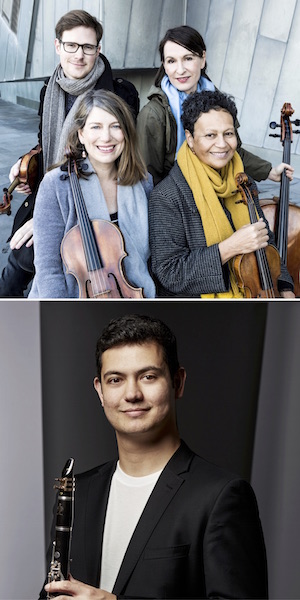Sydney Mozart Society
Affiliated with the Mozarteum, Salzburg
Sydney Mozart Society brings you Mozart and much more from the 'Golden Age' of Chamber music.

Flinders Quartet
Friday, 28 February 2020 at 8pm
Thibaud Pavlovic-Hobba (Violin), Wilma Smith ( Violin), Helen Ireland (Viola), Zoe Knighton (Cello), Lloyd Van’t Hoff (Guest Clarinet)
Flinders Quartet photo credit: Pia Johnson
Lloyd Van't Hoff photo credit: Keith Saunders
“... exciting and effervescent ... had the audience sitting up in their seats paying close attention to the impeccable intonation, rhythmic unity and open communication of the four players...” Classic Melbourne, March 2019
Tickets for this concert can be purchased in advance
- In person from The Concourse Box Office, Chatswood or from Ticketek agencies.
- By phoning the Ticketek Theatre & Arts Line 1300 795 012.
- Book tickets online through Ticketek
Programme
SCHUBERT String quartet no 12 in C minor, D 703, Quartettsatz
MOZART Quintet for in A for clarinet, two violins, viola and cello, K 581
INTERVAL
BEETHOVEN String quartet no 13 in B-flat major, Op 130
About the Artists
Flinders Quartet is instantly recognisable as one of Australia’s most loved chamber music ensembles. A quartet for the twenty-first century, the ensemble approaches its third decade with acknowledged musical skill and maturity, presenting dynamic and stirring performances of a full spectrum of repertoire.
Programme Notes
SCHUBERT String quartet no 12 in C minor, D 703, Quartettsatz
Franz Schubert was 24 years old when in 1820 he began work on his string quartet number 12. After completing the first Allegro movement and several bars of the second slow Andante movement, he put the work aside and never returned to it. The work was given its first public performance in 1867. The score, edited by Brahms, was published in 1870. It was given the simple title of Quartettsattz meaning Quartet Movement.
While there has been much speculation about Schubert’s reason for leaving the quartet unfinished, it is recognised as a significant work. Schubert was already an accomplished composer in many forms before he began the quartet, reaching new heights in the technical virtuosity and the emotional depth of the opening movement. It is a foretaste of his remarkable later string quartets.
The movement is in Sonata form. It begins with a theme of nervous apprehension that builds in tension and drama. The mood is soothed with the emergence of a warm sweetly melodic second theme. The development section expresses darker emotions, with insistent exchanges between violin and cello. In the recapitulation section, the second theme returns and intertwines gently and easily with a new third theme. A powerful restatement of the opening theme brings the movement to an exciting close.
C. B.
MOZART Quintet in A for clarinet and two violins, viola and cello, K 581
Allegro / Larghetto / Menuetto / Allegretto con variazioni
Mozart's clarinet quintet was composed in 1789 between the first two Prussian quartets. Even though the clarinet predominates as the first among equals, this work is in no way a concerto. Alfred Einstein suggests that Mozart treated the clarinet as if "he were the first to discover its charm, its 'soft, sweet breath', its clear depth, its agility". Mozart called the work "Stadler's quintet", having composed it for performance by his friend and fellow Freemason, Anton Stadler, for whom the later clarinet concerto was written as well.
The version of the quintet which is frequently heard is thought by experts to have been an arrangement for clarinet and strings of the original work which featured the basset clarinet, whose lowest note is one octave below middle C.
The development section of the first movement of the work has a concertante air about it, but for all five instruments, and the cantabile character of the second theme is resumed in the larghetto movement, where it is developed more fully. The third movement contains two trios most unusual for Mozart, except in serenades and divertimenti the first in a minor key for string quartet alone, and the second a Ländler, in which the clarinet becomes the rustic instrument which it was (and has remained) in South Bavaria and other alpine regions. The finale consists of five wonderful variations on a march-theme, followed by a coda.
M.C.
BEETHOVEN String Quartet no 13 in B flat major, Op 130
Programme notes for this work will be available nearer to the concert date.

Our venue and how to access it
Our concerts are held in the Concourse Concert Hall, Victoria Avenue Chatswood. With its superb acoustics, comfortable seating and many amenities, the Concourse Concert Hall is regarded as one of the best chamber music venues in Sydney.
Parking is available in the Concourse car park and in nearby shopping centre car parks. The venue is only a short walk from the Chatswood railway and bus transport interchange.
There are nearby restaurants and cafes, which give concert goers many options for dinner and socialising.
There is a licensed bar in the Concourse foyer where snacks, tea, coffee and drinks can be purchased before the concert from 7PM or during interval.
On concert nights, the Concourse foyer and terrace open at 7PM. Concert hall doors open at 7.30PM. Concerts begin at 8PM.
All tickets to Sydney Mozart Society concerts are general admission, seats are not numbered. The Concert Halll is spacious and good seating is assured.
Non-members are welcome
Single tickets for each of our 2020 season concerts are:
Adults, $50
Seniors/Pensioners, $47
Full-time students, $20
Children under 13, free admission
Tickets can be purchased in advance:
- In person from the Concourse Box Office or from Ticketek agencies.
- By phoning the Ticketek Theatre & Arts Line 1300 795 012.
- Online through the Ticketek website.
A Ticketek service delivery fee applies when tickets are booked by phone or online.